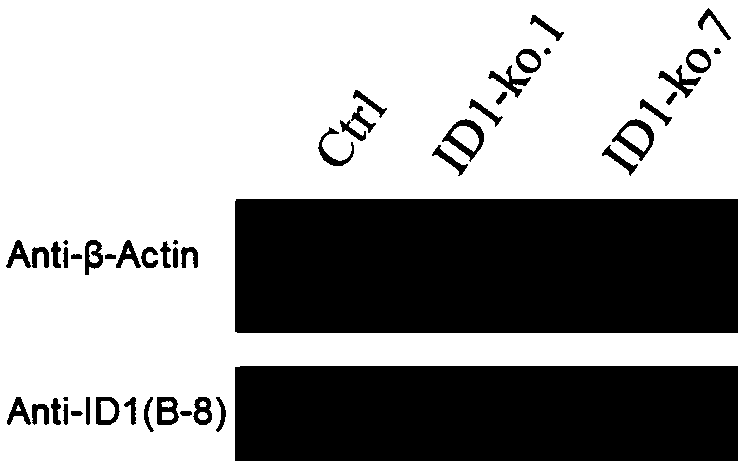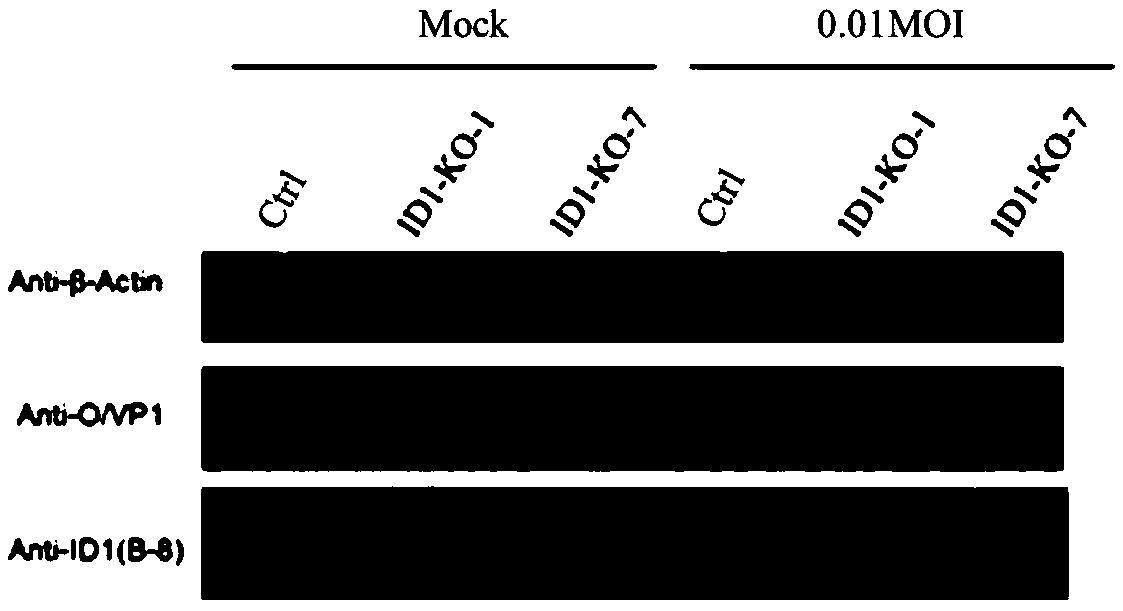sgRNA of ID1 (Inhibitor of Differentiation 1) genes, knock-out method for ID1 genes, BHK-21 cell line and application thereof
A technology of BHK-21 and cell lines, applied in the biological field, can solve problems such as economic losses, low virus titers, and complex O-type foot-and-mouth disease, and achieve the effect of increasing virus titers and reducing production costs
- Summary
- Abstract
- Description
- Claims
- Application Information
AI Technical Summary
Problems solved by technology
Method used
Image
Examples
Embodiment 1
[0040] A method for knocking out the ID1 gene in BHK-21 cells, comprising the steps of:
[0041]Find the gene sequence of ID1 in GenBank (NW_004801816.1 and XM_021223030), and use the sgRNA design website http: / / crispr.mit.edu / to obtain the sgRNA of the ID1 gene; the sgRNA sequence is shown in SEQ ID NO: 1-2;
[0042] Forward: SEQ ID NO: 1: caccgGGCGCGGGCGAGGTTGTGCT;
[0043] Reverse: SEQ ID NO: 2: aaacAGCACAACCTCGCCCGCGCCc.
[0044] Construct the sgRNA sequence in step (1) into the pspCas9(BB)-2A plasmid (available for purchase) to obtain a positive plasmid for future use;
[0045] It should be noted that since the construction methods in this step are relatively common methods in the field, they will not be described here one by one.
[0046] Cultivate BHK-21 cells, transfect when the cell density of BHK-21 reaches 60%-80%, and set aside;
[0047] Specifically, add 5-10 mL of sterilized PBS solution to BHK-21 cells, shake gently, rinse the cells, discard the PBS solution...
Embodiment 2
[0063] A method for knocking out the ID1 gene in BHK-21 cells, comprising the steps of:
[0064] (1) Find the gene sequence of ID1 in GenBank (NW_004801816.1 and XM_021223030), and then design the sgRNA of ID1 gene from http: / / crispr.mit.edu / website; the sequence of sgRNA is shown as SEQ ID NO: 3-4 shown;
[0065] Forward: SEQ ID NO: 3: caccgCGCCCTGCTGGACGAGCAGC;
[0066] Reverse: SEQ ID NO: 4: aaacGCTGCTCGTCCAGCAGGGCGc.
[0067] (2) Construct the sgRNA sequence in step (1) into the pspCas9(BB)-2A plasmid (available for purchase) to obtain a positive plasmid for future use;
[0068] It should be noted that since the construction methods in this step are relatively common methods in the field, they will not be described here one by one.
[0069] (3) Cultivate BHK-21 cells, transfect when the cell density of BHK-21 reaches 60%-80%, and set aside;
[0070] Specifically, add 5-10 mL of sterilized PBS solution to BHK-21 cells, shake gently, rinse the cells, discard the PBS sol...
Embodiment 3
[0085] Screening and identification of BHK-21 cell line with CRISPR-Cas9 targeted knockout of ID1, the specific steps are as follows:
[0086] Get the BHK-21 cells that knock out the ID1 gene in the first embodiment of the present invention, add puromycin at a final concentration of 3 μg / mL to screen for 5 to 7 days (the gene resistant to puromycin in the positive cells transfected into the plasmid will express, and will not be killed after adding puromycin; and the negative cells that have not been transferred to the plasmid do not express puromycin, and will be killed, and the final survivors obtained after screening are positive cells), and the cells are counted, 100 and 300 cells were plated respectively. After a single cell clone was formed one week later, a single clone was picked with a cloning ring, transferred to a 24-well plate, and expanded for culture. Genomic DNA and protein were extracted from the cells for identification, and then the positive cloned cell line w...
PUM
 Login to View More
Login to View More Abstract
Description
Claims
Application Information
 Login to View More
Login to View More - R&D Engineer
- R&D Manager
- IP Professional
- Industry Leading Data Capabilities
- Powerful AI technology
- Patent DNA Extraction
Browse by: Latest US Patents, China's latest patents, Technical Efficacy Thesaurus, Application Domain, Technology Topic, Popular Technical Reports.
© 2024 PatSnap. All rights reserved.Legal|Privacy policy|Modern Slavery Act Transparency Statement|Sitemap|About US| Contact US: help@patsnap.com










